Difference between revisions of "Gold leather"
(Created page with "<p align=center> 300px </p> <p align=center> 500px </p> ==Goldleder== '''Goldleder''' sind Leder, die durc...") |
|||
| (15 intermediate revisions by one user not shown) | |||
| Line 9: | Line 9: | ||
| − | == | + | ==Gold leather== |
| − | + | Giving leather a golden glow requires a [[finish|special finish]]. It was heavily used on [[leather wallpaper]] for royal and upper-class residences in Europe during the 16th - 18th century. | |
| − | + | Although one could assume that the golden surface of the leather comes from a gold leaf coating, it is actually silver leaf. Nevertheless, even if not real gold, the manufacturing process is still very expensive and complex. It requires practice and patience, as well as the background knowledge, to obtain the perfect gold shimmer. A special paint based on various resins was used for this purpose and its composition was a closely guarded secret during the Renaissance and Baroque periods. | |
| + | |||
| + | Gold leather was additionally decorated by [[Carving leather|carving]], [[Painting on leather|painting]] and [[Embossed leather|embossing]]. | ||
| Line 20: | Line 22: | ||
</p> | </p> | ||
<p align=center> | <p align=center> | ||
| − | ''[[ | + | ''[[Leather wallpaper]] with gold leather (silver leaf with paintwork) and embossing in the castle of Jever in Germany.''<br></p> |
<p> </p> | <p> </p> | ||
| Line 32: | Line 34: | ||
</p> | </p> | ||
<p align=center> | <p align=center> | ||
| − | '' | + | ''Today the tone or shade of gold leather is adjusted by dyeing or using foils.''<br></p> |
<p> </p> | <p> </p> | ||
| Line 40: | Line 42: | ||
</p> | </p> | ||
<p align=center> | <p align=center> | ||
| − | ''[[ | + | ''[[fish leather#Carp leather|Carp leather]] as gold leather topped with metallic film.''<br></p> |
<p> </p> | <p> </p> | ||
| Line 47: | Line 49: | ||
</p> | </p> | ||
<p align=center> | <p align=center> | ||
| − | ''[[ | + | ''[[Leather handbags|Leather handbag]] made of gold leather.''<br></p> |
<p> </p> | <p> </p> | ||
| Line 55: | Line 57: | ||
</p> | </p> | ||
<p align=center> | <p align=center> | ||
| − | '' | + | ''Two ladies' [[leather shoes|shoes]] made of gold leather from around 1895 ([[Leather museum|German Leather Museum in Offenbach)]].''<br></p> |
<p> </p> | <p> </p> | ||
| − | == | + | ==Hand gilding - Gold print - Press gilding - Engraving calligraphy== |
<p align=center> | <p align=center> | ||
| Line 65: | Line 67: | ||
| − | + | In the decoration of [[Leather book cover|book covers]] with gold leather, several techniques can be distinguished: | |
| − | * ''' | + | * '''Hand gilding''': This technique comes from the Islamic culture and existed way back in the 11th century, using tools to emboss the gold leaf onto the leather. It is a highly skilled technique and it is necessary to work very carefully to achieve clean transitions. |
| − | * ''' | + | * '''Gold print''': Motifs were pre-punched, then the area had to be primed. The rest of the areas where the gold was not going to be applied were oiled so that the gold leaf wouldn’t stay. The gold leaf was applied with cotton, pressed with a heated tool and the excess was rubbed off. |
| − | * ''' | + | * '''Press gilding''': Decorative motifs were applied using brass plates or stamps. Today, long sheets of gold foil are used by machines to gold plate the leather. |
| + | * '''Engraving calligraphy''': Transferring gold foil onto leather by hand using heat. | ||
| Line 76: | Line 79: | ||
</p> | </p> | ||
<p align=center> | <p align=center> | ||
| − | '' | + | ''Books with gold imprint.''<br></p> |
<p> </p> | <p> </p> | ||
<p align=center> | <p align=center> | ||
| − | [[bild: | + | [[bild:Prägerad-Goldprägung-01-Ledermuseum-Offenbach.jpg|500px]] |
| − | + | ||
</p> | </p> | ||
<p align=center> | <p align=center> | ||
| − | '' | + | ''[[Leather workshop|Tool]] for the application of gold stamping.''<br></p> |
<p> </p> | <p> </p> | ||
<p align=center> | <p align=center> | ||
| − | + | <flashow>//www.youtube.com/v/MwH1glXbNC4&fs=1&color1=0x660000&color2=0x550000&border=1|width=500|height=281,25</flashow> | |
</p> | </p> | ||
<p align=center> | <p align=center> | ||
| − | '' | + | ''Traditional engraving of book covers in gold in Paris.''<br></p> |
<p> </p> | <p> </p> | ||
| − | == | + | ==Leather inlays with gold embossing on tabletops== |
| + | Over the centuries, the use of leather inlays with gold embossing on tabletops has found favor in various cultures and eras. The practice of incorporating leather into tabletops has its roots in ancient Rome, where tables with intricately decorated leather inlays were created. These tables served not only as functional furniture pieces but also as status symbols, showcasing the wealth and taste of their owners. | ||
| + | |||
| + | |||
<p align=center> | <p align=center> | ||
| − | + | [[bild:Schreibtisch-Leder-01.jpg|500px]] | |
</p> | </p> | ||
| + | <p align=center> | ||
| + | [[bild:Furniture leather gold embossing 00.jpg|500px]] | ||
| + | </p> | ||
| + | <p align=center> | ||
| + | ''In the past, [[Leather table tops|table tops made of leather]] were often decorated with gold borders.''<br></p> | ||
| + | <p> </p> | ||
| + | During the Middle Ages and the Renaissance, this art form experienced a golden age. Magnificent tables with elaborate leather inlays were crafted, particularly in Europe, especially in Italy, France, and England. | ||
| − | < | + | |
| + | <p align=center> | ||
| + | [[bild:Furniture leather gold embossing 01.jpg|500px]] | ||
| + | </p> | ||
| + | |||
| + | |||
| + | The use of leather inlays with gold embossing on tabletops reached its peak during the Baroque and Rococo era in the 17th and 18th centuries. Tables adorned with elaborate designs, floral motifs, and delicate gold embellishments were highly popular during this time. These precious pieces were created by skilled artisans who brought their talent and craftsmanship into the creation of truly masterful works. | ||
| + | |||
| + | |||
| + | <p align=center> | ||
| + | [[bild:Furniture leather gold embossing 02.jpg|500px]] | ||
| + | </p> | ||
| + | |||
| + | |||
| + | With the advent of the Industrial Revolution in the 19th century, the production of leather inlays on tabletops with gold embossing became increasingly mechanized. Production techniques became more efficient, leading to a greater availability of these ornate tables. They found their place in many affluent households and were often regarded as objects of prestige. | ||
| + | |||
| + | |||
| + | |||
| + | |||
| + | ==[[Leather videos|Film]] about the peculiarities of [[Metallic leather|metallic effects]] on leather== | ||
| + | <p align=center> | ||
| + | <flashow>//www.youtube.com/v/RJJNNu1u2ts&fs=1&color1=0x660000&color2=0x550000&border=1|width=500|height=281,25</flashow> | ||
| + | </p> | ||
| − | == | + | == Additional information == |
| − | * [[ | + | * [[Metallic leather]] |
| − | * [[ | + | * [[Finish|Top colouration of leather]] |
| − | * [[ | + | * [[Leather colour]] |
Latest revision as of 19:14, 26 May 2023
Contents
Gold leather
Giving leather a golden glow requires a special finish. It was heavily used on leather wallpaper for royal and upper-class residences in Europe during the 16th - 18th century.
Although one could assume that the golden surface of the leather comes from a gold leaf coating, it is actually silver leaf. Nevertheless, even if not real gold, the manufacturing process is still very expensive and complex. It requires practice and patience, as well as the background knowledge, to obtain the perfect gold shimmer. A special paint based on various resins was used for this purpose and its composition was a closely guarded secret during the Renaissance and Baroque periods.
Gold leather was additionally decorated by carving, painting and embossing.
Leather wallpaper with gold leather (silver leaf with paintwork) and embossing in the castle of Jever in Germany.
Today the tone or shade of gold leather is adjusted by dyeing or using foils.
Carp leather as gold leather topped with metallic film.
Leather handbag made of gold leather.
Two ladies' shoes made of gold leather from around 1895 (German Leather Museum in Offenbach).
Hand gilding - Gold print - Press gilding - Engraving calligraphy
In the decoration of book covers with gold leather, several techniques can be distinguished:
- Hand gilding: This technique comes from the Islamic culture and existed way back in the 11th century, using tools to emboss the gold leaf onto the leather. It is a highly skilled technique and it is necessary to work very carefully to achieve clean transitions.
- Gold print: Motifs were pre-punched, then the area had to be primed. The rest of the areas where the gold was not going to be applied were oiled so that the gold leaf wouldn’t stay. The gold leaf was applied with cotton, pressed with a heated tool and the excess was rubbed off.
- Press gilding: Decorative motifs were applied using brass plates or stamps. Today, long sheets of gold foil are used by machines to gold plate the leather.
- Engraving calligraphy: Transferring gold foil onto leather by hand using heat.
Books with gold imprint.
Tool for the application of gold stamping.
Traditional engraving of book covers in gold in Paris.
Leather inlays with gold embossing on tabletops
Over the centuries, the use of leather inlays with gold embossing on tabletops has found favor in various cultures and eras. The practice of incorporating leather into tabletops has its roots in ancient Rome, where tables with intricately decorated leather inlays were created. These tables served not only as functional furniture pieces but also as status symbols, showcasing the wealth and taste of their owners.
In the past, table tops made of leather were often decorated with gold borders.
During the Middle Ages and the Renaissance, this art form experienced a golden age. Magnificent tables with elaborate leather inlays were crafted, particularly in Europe, especially in Italy, France, and England.
The use of leather inlays with gold embossing on tabletops reached its peak during the Baroque and Rococo era in the 17th and 18th centuries. Tables adorned with elaborate designs, floral motifs, and delicate gold embellishments were highly popular during this time. These precious pieces were created by skilled artisans who brought their talent and craftsmanship into the creation of truly masterful works.
With the advent of the Industrial Revolution in the 19th century, the production of leather inlays on tabletops with gold embossing became increasingly mechanized. Production techniques became more efficient, leading to a greater availability of these ornate tables. They found their place in many affluent households and were often regarded as objects of prestige.
Film about the peculiarities of metallic effects on leather
Additional information








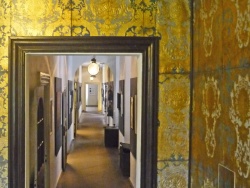
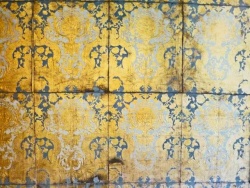
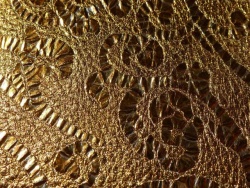
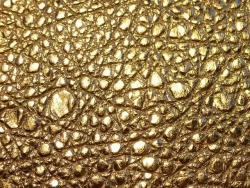
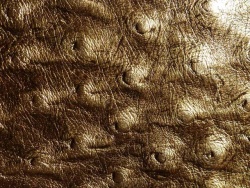
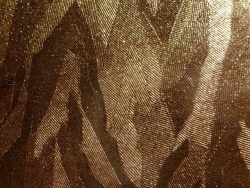
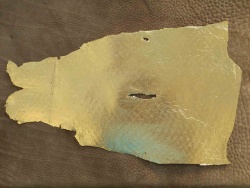
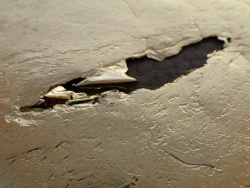
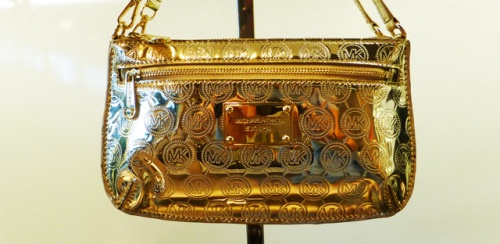
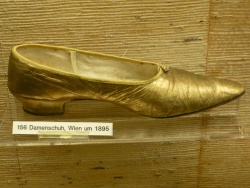
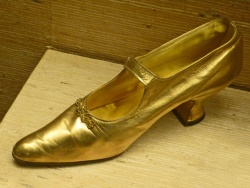

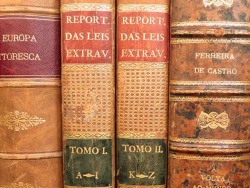
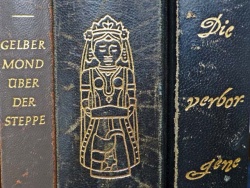
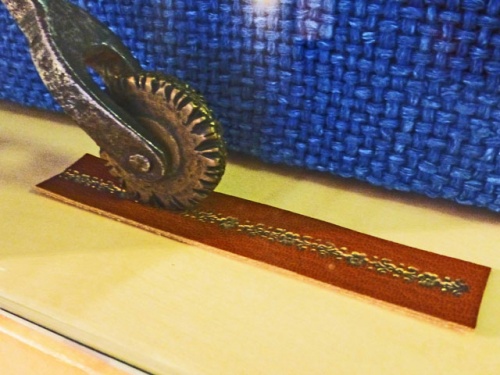
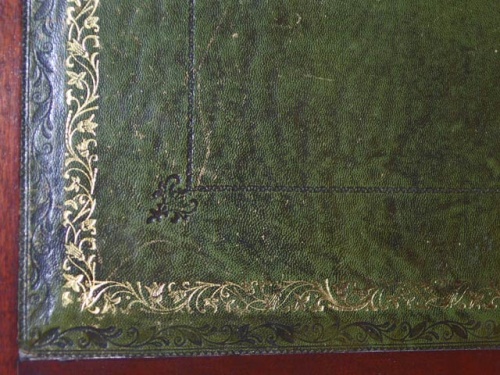
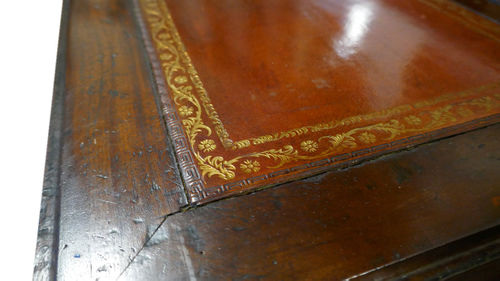
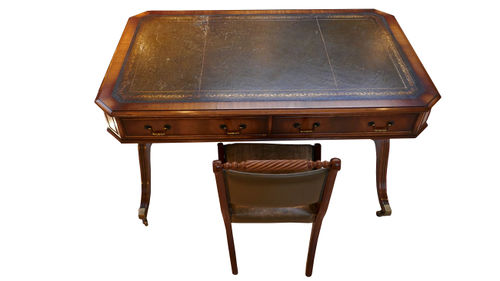
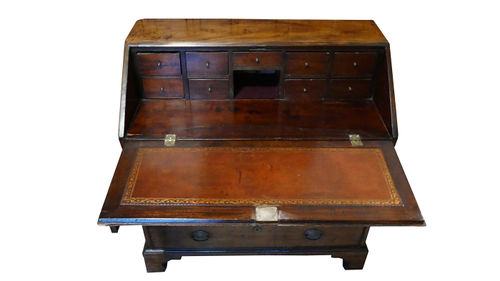

 a kotori web solution
a kotori web solution